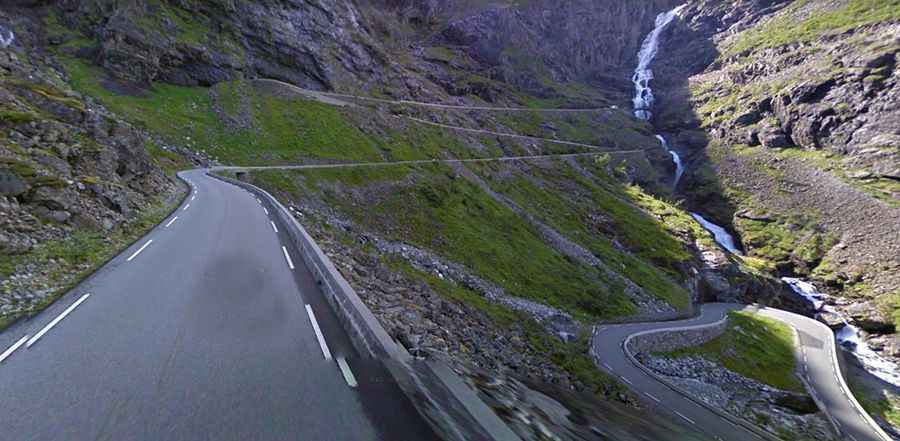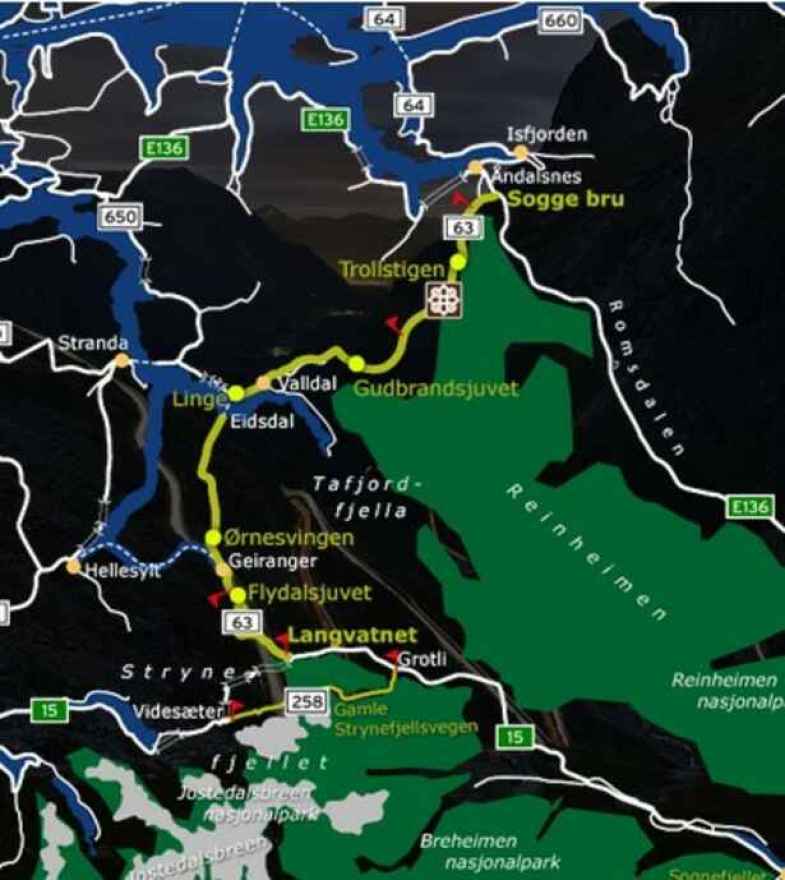The curvy Trollstigen is Norway's Most Famous Road
Trollstigen Mountain Road is one of Norway's most dramatic and most visited attractions, featuring dangerous conditions: steep gradients, narrow driving space, and poor traction and visibility in rain and fog. It's one of the famous scenic drives in Norway, known for its 11 hair-raising hairpin turns and a steep 10% gradient. Yet, despite the dangers of the one-lane road.

Where in Norway is Trollstigen road?
Set high in the mountains off the western coast of Norway, in Møre og Romsdal county, the curvy Trollstigen Road is part of Norwegian National Road 63 (Fv63). It’s located approximately 15 kilometers south of Åndalsnes.
How long is Trollstigen road?
The road is totally paved. It’s 49.9 km (31 miles) long, running south-north from Sylte (or Valldal) in Fjord Municipality to Åndalsnes in Rauma Municipality.
How long does it take to drive Trollstigen?
Plan around 2 hours to complete the drive. However, due to its beauty, plan a little longer. The road is also known as Norway's “golden route.” It’s the most visited tourist road in the country, and this masterpiece in engineering in the midst of majestic natural landscapes will make your drive a true joy ride. Driving Trollstigen is a dramatic and exciting experience. The road twists and climbs through a mountainous terrain of waterfalls, fjords, tunnels, and frozen lakes. It’s an exceptional driving experience along a route steeped in tradition, through the spectacular scenery of deep fjords and lush valleys - wild, wonderful, and vibrant.
Is Trollstigen worth visiting?
The road is a magnet for tourists. At the summit, there’s a parking area; a ten-minute walk brings visitors to a viewing balcony that overlooks the bends in the road as well as Stigfossen Waterfall. At some locations, you will discover that the road is carved into the mountain itself and in other places built-in stone. During the top tourist season, about 2,500 vehicles pass daily. According to Norwegian folk legend, trolls roam through the mountains of Trollstigen every night but change to stone when they are hit by sunlight each morning. Clouded in a veil of mist, their stone bodies create an unbelievable mass of cliffs and winding beauty that mesmerizes both visitors and Norwegians alike. There are ideal photography opportunities where you can pull over and capture the fjords and lush valleys below, and waterfalls so close you can touch them.
Where was James Bond No Time to Die filmed?
The road has been the set for countless car commercials and movies. It was featured in the James Bond film No Time to Die (2021).
Is Trollstigen safe?
Opened in 1936, it’s said to be one of Norway’s twistiest roads. It has a steep incline of 9 percent with 11 hairpin bends as it snakes its way along the steep mountainside at its highest point, Stigrøra, at an elevation of 857m (2,811ft) above sea level. The road brutally twists and turns through the mountainous terrain, and drivers can expect rock falls, narrow lanes, steep inclines, and unpredictable weather. The route is at its most dangerous in the dark and wet, making it incredibly challenging to navigate. The eleven magnificent hairpin turns of Trollstigen offer numerous highlights of fantastic scenery along the mountain road. Each bend has its own name, often named after the person who supervised the construction work on that particular section.
Is Trollstigen open now?
This road is closed during late autumn and winter. A normal operating season stretches from mid-May to October but may sometimes be shorter or longer due to weather conditions. But it can be closed anytime when the access is not cleared of snow. From Langvatnet to Geiranger is usually closed in November and reopens in May. Although the road has been widened in recent years, it’s still narrow. Unfortunately, the many hairpin bends make it unsuitable for buses longer than 12.4 meters. Most motorhome rental or campervan hire vehicles are shorter than that, but if you are undertaking this scenic drive, please check.
What does Trollstigen mean?
Trollstigen means 'ladder for a troll' or 'Troll's ladder.'
When was Trollstigen road built?
This road is an impressive piece of road building where the road snakes and climbs its way up and up along steep mountainsides. The bends and curves bear witness to the skill of the constructors, built upon the base rock of the steep mountainsides or hewn by hand into the mountain itself. Being able to drive up these steep mountainsides is thanks to the skills of engineers and road builders. For several centuries the road was an important transport artery between Valldal and Åndalsnes, first as a path and then as a bridleway. The construction of the Trollstigvegen road started up in 1916 and opened on 31 July 1936, by King Haakon VII. The long construction period has to do with the long winters without any possibility to get any work done. Before that, farmers on both sides of the mountain had worked hard on construction and improvement of the cart track that existed before the road opened. You can also actually still see parts of the original pack horse track in some places alongside the current road.
